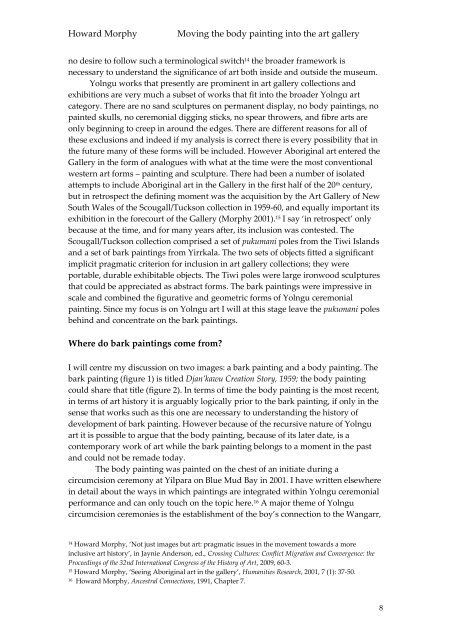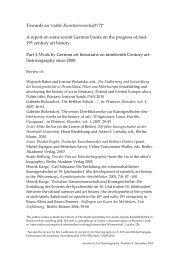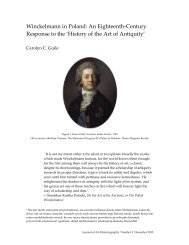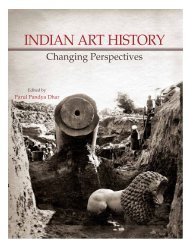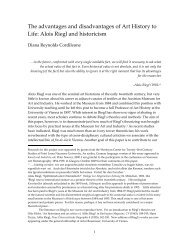Moving the body painting into the art gallery - Journal of Art ...
Moving the body painting into the art gallery - Journal of Art ...
Moving the body painting into the art gallery - Journal of Art ...
You also want an ePaper? Increase the reach of your titles
YUMPU automatically turns print PDFs into web optimized ePapers that Google loves.
Howard Morphy <strong>Moving</strong> <strong>the</strong> <strong>body</strong> <strong>painting</strong> <strong>into</strong> <strong>the</strong> <strong>art</strong> <strong>gallery</strong><br />
no desire to follow such a terminological switch 14 <strong>the</strong> broader framework is<br />
necessary to understand <strong>the</strong> significance <strong>of</strong> <strong>art</strong> both inside and outside <strong>the</strong> museum.<br />
Yolngu works that presently are prominent in <strong>art</strong> <strong>gallery</strong> collections and<br />
exhibitions are very much a subset <strong>of</strong> works that fit <strong>into</strong> <strong>the</strong> broader Yolngu <strong>art</strong><br />
category. There are no sand sculptures on permanent display, no <strong>body</strong> <strong>painting</strong>s, no<br />
painted skulls, no ceremonial digging sticks, no spear throwers, and fibre <strong>art</strong>s are<br />
only beginning to creep in around <strong>the</strong> edges. There are different reasons for all <strong>of</strong><br />
<strong>the</strong>se exclusions and indeed if my analysis is correct <strong>the</strong>re is every possibility that in<br />
<strong>the</strong> future many <strong>of</strong> <strong>the</strong>se forms will be included. However Aboriginal <strong>art</strong> entered <strong>the</strong><br />
Gallery in <strong>the</strong> form <strong>of</strong> analogues with what at <strong>the</strong> time were <strong>the</strong> most conventional<br />
western <strong>art</strong> forms – <strong>painting</strong> and sculpture. There had been a number <strong>of</strong> isolated<br />
attempts to include Aboriginal <strong>art</strong> in <strong>the</strong> Gallery in <strong>the</strong> first half <strong>of</strong> <strong>the</strong> 20 th century,<br />
but in retrospect <strong>the</strong> defining moment was <strong>the</strong> acquisition by <strong>the</strong> <strong>Art</strong> Gallery <strong>of</strong> New<br />
South Wales <strong>of</strong> <strong>the</strong> Scougall/Tuckson collection in 1959-60, and equally important its<br />
exhibition in <strong>the</strong> forecourt <strong>of</strong> <strong>the</strong> Gallery (Morphy 2001). 15 I say ‘in retrospect’ only<br />
because at <strong>the</strong> time, and for many years after, its inclusion was contested. The<br />
Scougall/Tuckson collection comprised a set <strong>of</strong> pukumani poles from <strong>the</strong> Tiwi Islands<br />
and a set <strong>of</strong> bark <strong>painting</strong>s from Yirrkala. The two sets <strong>of</strong> objects fitted a significant<br />
implicit pragmatic criterion for inclusion in <strong>art</strong> <strong>gallery</strong> collections; <strong>the</strong>y were<br />
portable, durable exhibitable objects. The Tiwi poles were large ironwood sculptures<br />
that could be appreciated as abstract forms. The bark <strong>painting</strong>s were impressive in<br />
scale and combined <strong>the</strong> figurative and geometric forms <strong>of</strong> Yolngu ceremonial<br />
<strong>painting</strong>. Since my focus is on Yolngu <strong>art</strong> I will at this stage leave <strong>the</strong> pukumani poles<br />
behind and concentrate on <strong>the</strong> bark <strong>painting</strong>s.<br />
Where do bark <strong>painting</strong>s come from?<br />
I will centre my discussion on two images: a bark <strong>painting</strong> and a <strong>body</strong> <strong>painting</strong>. The<br />
bark <strong>painting</strong> (figure 1) is titled Djan’kawu Creation Story, 1959; <strong>the</strong> <strong>body</strong> <strong>painting</strong><br />
could share that title (figure 2). In terms <strong>of</strong> time <strong>the</strong> <strong>body</strong> <strong>painting</strong> is <strong>the</strong> most recent,<br />
in terms <strong>of</strong> <strong>art</strong> history it is arguably logically prior to <strong>the</strong> bark <strong>painting</strong>, if only in <strong>the</strong><br />
sense that works such as this one are necessary to understanding <strong>the</strong> history <strong>of</strong><br />
development <strong>of</strong> bark <strong>painting</strong>. However because <strong>of</strong> <strong>the</strong> recursive nature <strong>of</strong> Yolngu<br />
<strong>art</strong> it is possible to argue that <strong>the</strong> <strong>body</strong> <strong>painting</strong>, because <strong>of</strong> its later date, is a<br />
contemporary work <strong>of</strong> <strong>art</strong> while <strong>the</strong> bark <strong>painting</strong> belongs to a moment in <strong>the</strong> past<br />
and could not be remade today.<br />
The <strong>body</strong> <strong>painting</strong> was painted on <strong>the</strong> chest <strong>of</strong> an initiate during a<br />
circumcision ceremony at Yilpara on Blue Mud Bay in 2001. I have written elsewhere<br />
in detail about <strong>the</strong> ways in which <strong>painting</strong>s are integrated within Yolngu ceremonial<br />
performance and can only touch on <strong>the</strong> topic here. 16 A major <strong>the</strong>me <strong>of</strong> Yolngu<br />
circumcision ceremonies is <strong>the</strong> establishment <strong>of</strong> <strong>the</strong> boy’s connection to <strong>the</strong> Wangarr,<br />
14 Howard Morphy, ‘Not just images but <strong>art</strong>: pragmatic issues in <strong>the</strong> movement towards a more<br />
inclusive <strong>art</strong> history’, in Jaynie Anderson, ed., Crossing Cultures: Conflict Migration and Convergence: <strong>the</strong><br />
Proceedings <strong>of</strong> <strong>the</strong> 32nd International Congress <strong>of</strong> <strong>the</strong> History <strong>of</strong> <strong>Art</strong>, 2009, 60-3.<br />
15 Howard Morphy, ‘Seeing Aboriginal <strong>art</strong> in <strong>the</strong> <strong>gallery</strong>’, Humanities Research, 2001, 7 (1): 37-50.<br />
16 Howard Morphy, Ancestral Connections, 1991, Chapter 7.<br />
8


